|
PRELIMINARY
RESULTS ON THE TROPHIC DYNAMICS OF THE GULF OF NICOYA, COSTA RICA SCIENTIFTC
NOTE
Trabajo recibido el 3 de mayo de 1984 y aceptado para su
publicación el 20 de septiembre de 1984.
JORGE CAMPOS
CIMAR.Universidad
de Costa Rica. San Pedro, Costa Rica.
ADOLFO CORRALES
Escuela de
Biología.
Este trabajo representa el primer
intento para describir la dinámica trófica del Golfo de Nicoya.
Se encontró que los crustáceos representan un 58.4 % del total de
organismos presa encontrados y, de los crustáceos, los camarones
constituyen un 46 % del total. Los peces (18.2 % ), ofiúridos (7.8 %),
poliquetos (7.4 % ) y moluscos (3.6 % ) les siguieron en importancia. Con esta
información se construyó una pirámide trófica que
indica que de la ictiofauna analizada, un 52.3 % es omnívora, un 33.4 %
es carnívora de primer orden y un 14.3 % es carnívora de segundo
orden. Esta información es discutida en función de su importancia
para las pesquerías y el manejo de zonas costeras.
Palabras clave: dinámica trófica,
Golfo de Nicoya.
This work represents a first attempt
to descrive the trophic dymanics of the Gulf of Nicoya. The crustaceans
represented 58.4 % of the total number of prey organisms found and among
crustaceans, shrimp were 46 % of the total. Fish (18.2 %), ophiurids (7. 8 %),
polychaetes (7.4 % ) and mollusks (3.6 %) followed in decreasin order. Based on
this information a trophic pyramid was built an indicated that of the studied
ichthyofauna, 52.3 % are omnivorous, 33.4 % second order carnivores and 14.3 %
first order carnivores. These data are discussed with regards to its impact on
the fisheries and coastal management of the Gulf of Nicoya.
Key words: trophic dynamics, Golfo de
Nicoya.
The Costa Rican fishing industry harvests a moderate resource which yields no more than 25,000 annual metric tons per year. The Gulf of Nicoya an estuarine system bordered by mangrove forests - some altered and some threatened- is the country's most important fishing center. Shrimp trawlers sweep its floor searching for white shrimp and cause great mortality to other invertebrates and fishes. This anthropormorphic impact over the mangroves, the ichtiofauna and meiofauna threatens the stabílity of a system which is consídered a nursery area for some of the commercial ichthyofauna of the Gulf and some migratory species such as sharks (Madrigal, E., personal communication, 1983). In tropical estuarine system with strong fishing pressure, environmental alterations such as deforestation of mangroves and high species diversity, a comprehensive view of the existing trophic dynamies is basic to understand the energy flow in the system and to achieve an adequate management of the commercially exploited species. In such a multispecies system, commercially important species may coexist with species of neglectable commercial value, but which nonetheless serve as potential prey for those harvested commercially. (Austin and Austin, 1971; Yáñez-Arancibia, 1978). Stomach contents analysis in fishes is used to enlighten the prevailing dinamics –predator - prey, competition– between the members of a community. This work representes a first attempt to assess, based on our data and information for other tropical estuarine systems, the trophic dynamies of the Gulf Nicoya, the main paths of energy flow through the system, and to identify research needs. MATERIAL AND MÉTHODSData were collected monthly from March to November 1982, at 8 stations of the Gulf of Nicoya (Fig. 1). A bottom trawl was towed for 10 minutes at each station with a 10 meters headrope length, 4.5 cm streched mesh. The stations selected for this 10 month study were basically the same monitored during a four year cooperative research program of the Gulf of Nicoya between the University of Delaware and the University of Costa Rica. The samples were transported to the laboratory in lee for analysis. Two hundred and ninety three fish were caught, identified, measured for total length and disected. Percentage composition of the contents by major taxonomic groups was estimated visually (Hyslop, 1980) with a B & L Stereo Zoom. Contents were identified to species level whenever possible. When material was partially digested the parts of each organism were utilized to indicate its presence i.e, fish spinal columns, pairs of shrimp chelipeds. 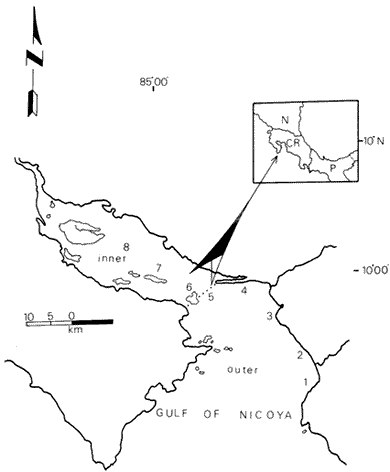 Fig. 1. Map of the Gulf of Nicoya showing the stations sampled during this study (1-8). Notation: N = Nicaragua; CR = Costa Rica; P = Panamá. RESULTS AND DISCUSSIONTable 1, gives the compositon by the taxonomic groups found in the stomach of the 21 species studied. Shrimp is a significatn component of contents of most of the species. Other species feed mainly on ophiurids and polychaetes. Isopisthus remifer, Cynoscion phoxocephalus and C. squamipinis showed a greater occurrence of fish in their diets. Three species, Anisotremus dovii, Stellifer chrysoleuca and Diapterus peruvianus had a relatively higher percentage of mollusks in their stomachs. It is difficult to assure if there is a preference for them or if they are accidentally taken while feeding. Figure 2, shows the percentage contribution of each of the prey groups to the total found. Crustaceans are the dominant group and among them, shrimpare the most abundant component. Table 2 lists the shrimp species found in the stomachs. Trachipeneaus and Protrachypene are the commonest but many shrimp were not identified because their rostrums were missing. Although the results showed in figure 2 summarize the contributions of prey of all the disected specimens, other studies (Rutherford et al., 1982; Clairo and Lapin, 1971; Silva, 1974) show that is the case of Cynoscion nebolusus, Lutianus synagris and Epinephelus striatus crustaceans represented respectively, 43.5 %, 52.0% and 55.7% of the total stomach contents. 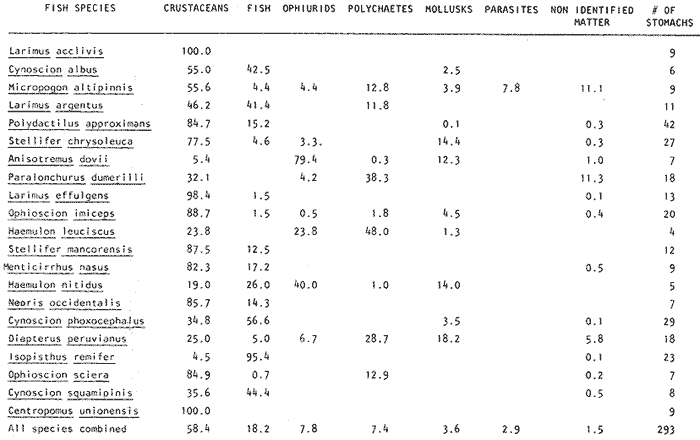 TABLE 1 PERCENTAGE COMPOSITION OF STOMACH (BY MAJOR TAXONOMIC GROUPS) OF FISHES FROM THE GULF OF NICOYA, COSTA RICA. The faunal composition indicated here probably underestimates the real diet of the studied ichthyofauna, because our sampling schedule varied between 7:00 to 16:00 hours and was not based on peak feeding times. Other factors such as: a) fast digestion rates in tropical fishes (Reshetnikov et, al., 1974); b) the use of a trawl net to sample which provokes regurgitation in some fish; and e) not having considered changes in diet with size (Rodríguez, 1962; Austin and Austin, 1971; Rutherford et al., 1982) made it difficult to find the full array of prey organisms consumed. However, results found similar areas by other authors cited elsewhere in the text indicate that we have a good view of the prevailing feeding patterns. 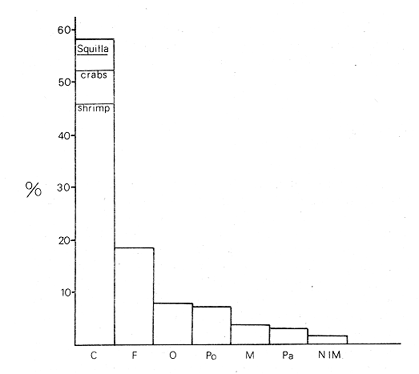 Fig. 2. Percentage contribution of each major taxonomic group to the total number of organisms found in the stomachs analyzed. Data from the Gulf of Nicoya, Costa Rica. Notation: C=crustaceans (Squila=6.1 crabs=6.5%; shrimp=45.7%); F=fish; 0=Ophiurids, Po=Polichaetes; M=Mollusks; Pa=Parasites; NIM=Non identified matter. Two aspects derived of the previous discussion deserve examination, 1) why crustaceans are the dominant prey item and 2) probable implications of their abundance as a prey item: High abundance of crustaceans in the Gulf could lead to dominance in the stomachs of the fish species studied. At the eastern margin of the Gulf of Nicoya - which coincides with the sampled area in this study- shrimp represented annually, on the average, 80 % of the total number of invertebrates and 50 % of the total biomass (Maurer et. al., 1980). This argument may sound too simple to reflect the feeding dynamies of the studied species. However, excluding the energetie value of the individual prey consumed, crustacean abudance could considerably reduce the searching time of the predator and maximize energetie consumption per unit time.  TABLE 2 SHRIMP SPECIES FOUND IN STOMACHS OF THE STUDIED ICHTHYOFAUNA OF THE GULF OF NICOYA, COSTA RICA 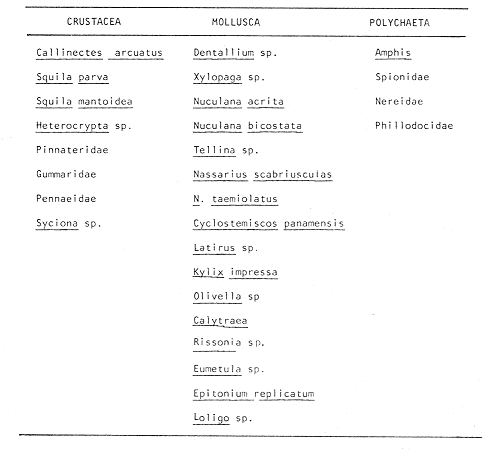 TABLE 3 ORGANISMS FOUND IN STOMACH CONTENTS OF THE ICHTHYOFAUNA FROM THE GULF OF NICOYA, COSTA RICA. CONTENTS WERE IDENTIFIED TO ESPECIES LEVEL WHENEVER POSSIBLE Of the identified prey listed in Table 3 mollusks are the more diverse. However, their abundance in stomachs of all species combined is less than 4% of the total (this could be explained by using the reverse argument of the one for shrimp). Maurer et al. (1980) states that gastropods represent, on the average, 0.35 % of the total number of invertebrates foud and 6% of the total biomass. Protection and food availability determine a substrate as a suitable habitat for shrimp (Williams, 1958; Turner, 1977; Bradford, 1981). The properties of the substrate depend substancially on river runoff. Mangrove leaves are one of the main components of debris transported by rivers draining mangrove channels and estuaries; and transported whole, broken or as detritus, partially condition the quality of the substrate in terms of softness, organic content and partiele size. This organic detritus provides a substrate for microbes, bacteria, yeasts and fungi which are consumed by shrimp (Evink, 1975; Velez, 1978; Yáñez-Arancibia, 1978; Prahl, 1980; Odum, 1980) Other crustaceans such as crabs also depend directly on this substrate as part of their diet and indirectly since they prey upon crabs annelids, and mollusks associated with andior feeding on the detritus (Yáñez-Arancibia, 1978; Velez, 1978). Based on this review and our results, we could hypothesize that approximately 50 % of the prey to sustain the studied ichthyofauna depend on aloctonous material coming from mangroves swamps next to the fishing areas. Although this discussion emphasizes the importance of mangrove forests for the perpetuation of crustacean resources, we should not forget that the sum of several variables such as rainfall, recruitment, and environmental change at the nursery areas, condition the grater or lesser abundance of crustaceans and other invertebrates (Gunther and Edwards, 1967; Saldaña and López, 1969). Figure 3, shows a trophic pyramid using results of Table and following Yasuda's criteria (In: YáñezArancibia, 1978) for its construction. Eleven species (52.3%) are found to be omnivores and feed on three or more of the prey groups listed in Table 1. Seven species (33.4 %) were considered second order carnivores and feed mainly on shrimp and fish and ocasionally on squid (i.e. C. albus). The other three species (14.3 %) were considered first order carnivores and feed specially on fish and shrimp. C. phoxocephalus shows a 3.4 % of mollusks (squid) in the stomachs but because of the high percentage of fish consumption was considered a first order carnivore. We are aware that this figure represents a broad generalized picture of the trophic scheme of the Gulf of Nicoya. There are many piscivorous fishes such as native sharks from the Gulf of Nicoya, migratory hammerheads which use the Gulf as a nursery area, carangids, lutjanids, scombrids and larger specimens of some of the studied species (C. phoxocephalus. C. squamipinis, Centropomus unionensis among others) which were not captured by the shrimp trawling net probably because of their fast swiming. 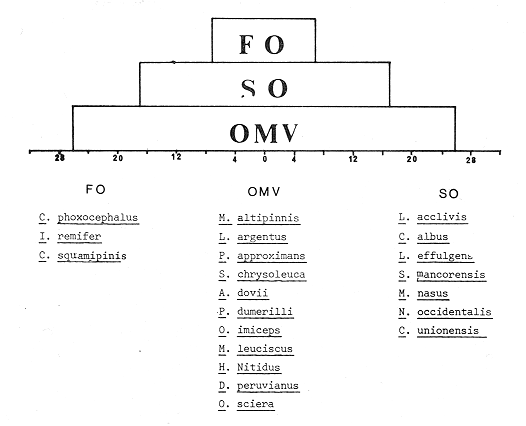 Fig. 3. Trophic pyramid based on results stomach content analysis of the ichthyofauna from the Gulf of Nicoya, Costa Ríca. Notation: FO = first order carnivores; SO = second order carnivores; OMV = omnivores. In a lagunar or estuarine system such the Gulf of Nicoya there are two main types of food chains, one based on grazing and the other on detritus feeding. First order consumers include most zooplankters, fish, shrimp and crabs. This diverse group comprises hervivores, detritivores and omnivores (Day and Yáñez-Arancibia, 1982). The crustaceans, annelids, mollusks and other detritivores and omnivores invertebrates found as prey in this study can be considerer as first order consumers of the Gulf of Nicoya. These invertebrates as well as omnivorous fishes depend on some energetic source other than the phytoplankton. Here, the detrital chain, mangrove and other trees and plants which supply organic detritus, detritus consumers, omnivores and carnivores could constitute such additional route. It should be remembered that even when the detritus chain is ecologically and economically very important for a system such a Gulf of Nicoya, the role of phytoplankton should not be overestimated, specially regarding ichthyoplankton feeding dynamies (Odum et al., 1982). The Gulf of Nicoya is fished intensively by both the artisanal and the industrial commercial fishery and shrimp trawling is specially intense in the outer Gulf (Fig. 1). Additionally, mangrove cutting for land reclamation and charcoal have been slowly modifying these marginal ecosystem of the Gulf. If our results on prey consumption are taken for all species combined, we identify two inmediate research priorities. a. To depen our understanding of the trophic dynamies of the Gulf where it appears that part of the commercial ichthyofauna rely over 50 % on crustaceans (specially shrimp) as a prey item, and. b. To highlight the role of mangrove ecosystems in the eco logy of the Gulf of Nicoya. AgradecimientosACKNOWLEDGEMENTSWe wish to express our gratitude to Eduardo Madrigal from their Fisheries Department for his help with fisheries data; to David Stevenson from the University of Maine and to Bradford Brown from the Northeast Fisheries Center, for reviewing a preliminary copy of this paper; to Carlos Villalobos, Ana Dittel, William Bussing and Myrna López who identified most invertebrates and fish and to Norma Bermúdez who typed it. This work was funded by grant No. 02071424 from the Vicerrectory for Research of the University of Costa Rica. LITERATURAABBOT, R.T. American Seashells. Van Nostrand Reinhold Company. New York USA 1974 633 p. AUSTIN, H. and Sh. AUSTIN. The feeding habits of some juvenile marine fishes from mangroves in western Puerto Rico, Carib. J. Sci. 1971 11 (3-4) BRANDFORD, J.R. Sediment preferences and morphometric equations for P. monodon and P. indicus from creeks of the Red Sea. Estuarine Coastal and Shelf Science 1981 13 CLAIRO, R. and V. L. LAPIN Algunos datos sobre la alimentación y la dinámica de las grasas de la bijaiba Lutjanus synagris (Linnaeus) en el Golfo de Batanamo, plataforma sur de Cuba. Serie Oceanológica Academia de Ciencias de Cuba. Instituto de Oceanología. 1971 16 p. 10 DAY, J.W. and A., YÁÑEZ-ARANCIBIA. Coastal lagoons and estuaries ecosystems approach.ISSN-009 675X. Ciencia Interamerícana, OEA Washington, D. C. 1982 22 (1-2) EVINK, G. L. Proceedings of the International Symposium of the Biology and Management of Mangroves. Macrobenthos comparisons in mangroves estuaries. C. Walsh, S. Snedaker and H. Teas University of Florida, Gainesville. 1975 p. 256-285. GUNTER, C. and C. J., EDWARDS The relation of rainfall and freshwater drainage to the production of penaeid shrimp (Peneaus fluvialis Say and P. aztecus Ives) in Texas and Louisianna waters. Duke Univ. Mar. Lab. N. Car. USA 1967 HYSLOP, E.J. Stomach content analysis -a review of methods and their application. J. Fish Biol. 1980 411-429 17 (4) KEEN, A.M. Sea Shells of Tropical West America. Stanford University Press. 1971 1064 p. MADRIGAL, E. Department of Fisheries. Ministry of Agriculture, Costa Rica. Personal communications. 1983 MAURER, D., Ch. Epifanio, and K. Price. Progress Report of the 1979 Internacional Sea Grant Program. Ecological assessments of firifish and megabenthic invertebrates as indicators of natural and impacted habitats in the Gulf of Nicoya, Costa Rica. College of Marine Studies, University of Delaware. 1980 ODUM, W.E., C. CAROLE, Mc IVOR and J. THOMAS SMITH III, . The ecology of mangroves of South Florida: A community profile. Biological Services Program. FWS/OBS-81/24. Bureau od Land Management. Fish and Wildlife Service, U.S. Department the Interior. 1982 PRAHL, H. Memorias del Seminario Sobre el Estudio Cíentifico e Impacto Humano en el Ecosistema de Manglares. ISBN 92-3-00 1810-4. Importancia del manglar en la biología de los camarones peneidos. Oficina Regional de Ciencias y Tecnología de UNESCO para América Latina y el Caribe. 1980 RODRIGUEZ, P.Z. Estudios estadísticos y biológicos sobre la bijaiba (Lutianus synagris). Notas de Invest. Centro de Investigaciones Pesqueras. Habana 1962 4 RUTHERFORD, E. THUE and D. BUKER Population characteristics, food habits and spawning activities of spoted seatrout, Cynoscion nebulusus in Everglades national park, Florida, Report T-668. National Park Service. South Florida Research Center. Everglades National Park. 1982 SALDAÑA, CH. H. and S. R. LÓPEZ Lagunas Costeras, un Simposio, Mem. Simp. Intem. Lagunas Costeras. Resultados preliminares del estudio ecológico y pesquero de las lagunas litorales del sur de Sinaloa, México. UNAM-UNESCO 1969 nov. 2830, 1967 SILVA, L.A. Hábitos alimentarios de Epinephelus striatus (Bloch) y algunos datos sobre su biología. Serie Oceanológica Academica de Ciencias de Cuba. Instituto de Oceanología. 1974 15p. 25 TURNER, E.R. Intertidal vegetation and commercial yields of pennaeid shrimp. Trans. Amer. Fish. Soc. 1977 106 5 VÉLEZ, V.M. El Ecosistema de Manglares. Comunicaones de la Sociedad Malacológica del Uruguay 1978 347-364 4 VENKATARAMIAH, A., G.J. KAKSHMI and G. GUNTER Studies on the effect of salinity and temperature on the commercial shrimp P. aztecus (Ives) with special regard to survival limits, growth, oxigen consumption and ionic regulation. Contract Report H-74-2 U.S. Army Enginner Waterways Experiment Station, Vicksburg. Mississippi. 1974 WILLIAMS, A. Límnology and Oceanography Substrate as a factor in shrimp distribution 1958 3 YÁÑEZ-ARANCIBIA, A. Taxorromía y estructura de las comunidades de peces en lagunas costeras con bocas efímeras del Pacífico de México. Centro de Cienc. del Mar y Limnol. Univ. Nal. Autón México, Public. Espec. 1978 1-306 2
|

